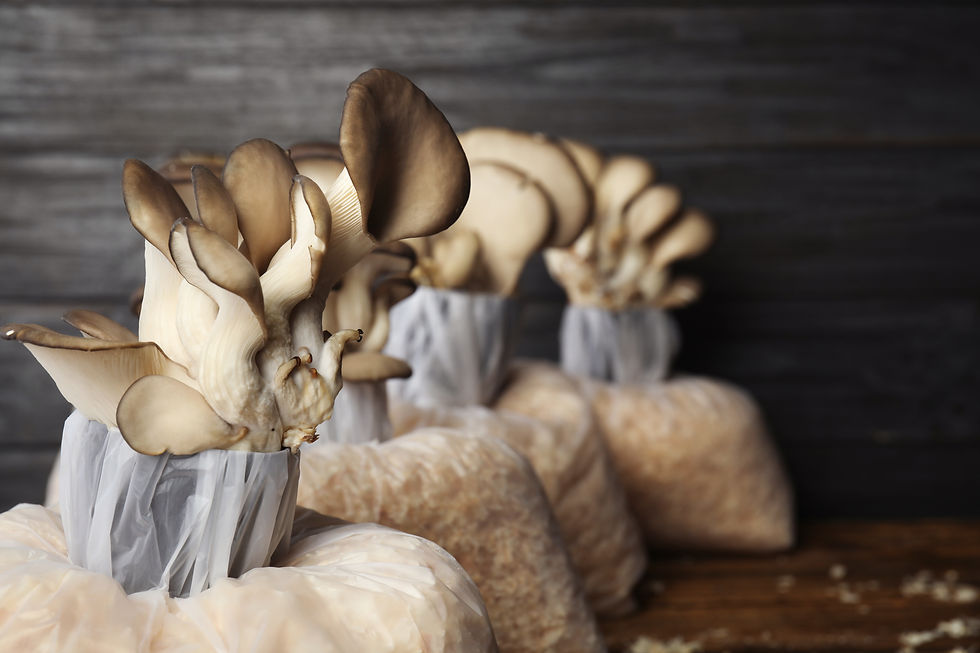Falling For Fungi

If you enjoy growing some of your own food, don’t stop at tomatoes and herbs. Mushrooms can be fun to grow and crazy healthy to eat. They’re fat-free, low-cal, and packed with vitamins, antioxidants, and other nutrients. They’ve even been called a brain-healthy superfood. Although, they can be finicky to get started, once you give them the conditions they want and get them growing, they’ll knock your socks off with their daily metamorphosis.
I began my mushroom growing adventures with a kit I got for Mother’s Day, a mushroom “block.” Within a week, I had robust crops of brown oyster and white oyster mushrooms growing on my windowsill, and they had the whole family riveted as my fungi doubled in size each day. I harvested them and made killer chicken parm with one, stroganoff with the other. I was hooked!
My foray into mushroom foraging began when we hired a couple to landscape our yard, who turned out to be mushroom hunters. They pointed out a bountiful crop of chanterelles growing on a wooded section of our property. After three evenings of studying them in books and videos, I whipped up a wild chanterelle risotto with them. Ooh, la la!
Here’s the part where I tell you please, please, please don’t eat any mushroom you find, until you know what they are. I had mine validated by experienced mushroom hunters and still did copious research. There are field guides, phone apps, websites, and mushroom clubs to help with identification. When in doubt, DON’T eat them!
Next, I bought living morel fungus from a company on Amazon and planted a perennial crop of morels. Mushrooms grow from spores — not seeds — and thrive in sawdust, grain, straw, or woodchips — not soil. A blend of spores and these nutrient materials is called “spawn,” which is a little like starter you may have used to make sourdough bread. Mine took a couple of years to get going, but they can produce pounds of morels each spring for decades once established. Now, we’re enjoying fresh-from-the-earth morels on pizza, in omelets, and in linguini. You can start your mushroom adventure with a commercial kit. Some grow right in the box they come in. My block allowed me three consecutive harvests.
Others come with hand-cut logs inoculated with fungal spores (mycelium) and covered with cheese wax for protection from insects and other natural predators. One of the beauties of growing your own mushroom varieties, rather than wild harvesting them, is knowing what you’re getting. If you have young kids in your life, be sure to get them involved as you all start falling for fungi. If you’re brave, look for a mushroom foraging club in your area. Facebook is an excellent place to start. If you take all the proper precautions, there’s nothing more exciting than “getting your eyes on” and finding a healthy crop of edible mushrooms in the wild.
MAD ABOUT MUSHROOMS
Order your own mushroom growing kit
• ForestOrigins.com • NorthSpore.com • BacktotheRoots.com • GMHP on Amazon.com
Sources to help identify mushrooms in the wild
• Wild Edibles by Steve Brill
• Audubon Mushrooms Guidebook
• Mushrooms Demystified by David Aurora
• The Complete Mushroom Hunter by Gary Lincoff
Identification apps
• Rogers Mushrooms • Book of Mushrooms • Fungitron Mushroom Guide
There are Texas mushroom groups on Facebook and Reddit. If you want to be sure of your mushroom type and freshness, try purchasing them from your farmer’s market or local health food store. Remember, when in doubt, don’t eat them!


















